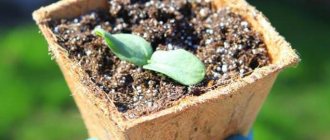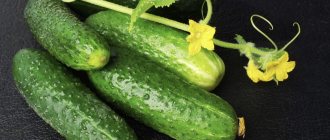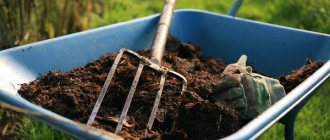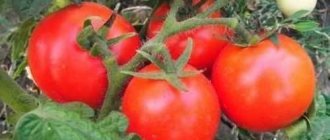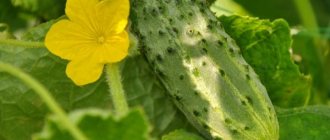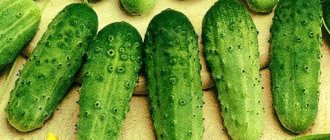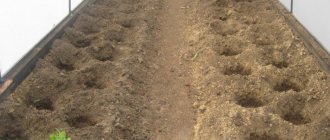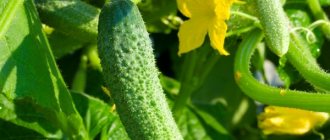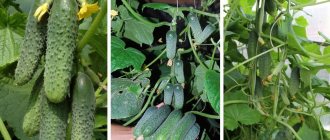Vegetable growing » Cucumbers
0
1425
Article rating
Kira Stoletova
Vyuga F1 is a hybrid from a St. Petersburg company. The Vyuga cucumber variety is an ultra-early variety. Since the hybrid is parthenocarpic and does not require pollination by insects, it is suitable for growing both in greenhouses (for regions with a cool climate) and in open beds.
Description of the cucumber variety Vyuga
Description and characteristics of the variety
Vyuga F1 from Biotechnika was bred by crossing 2 super early varieties. The originator is a St. Petersburg agricultural company. The hybrid turned out to be cold-resistant and hardy.
The harvest begins very early - 37-40 days from germination.
The hybrid is parthenocarpic and does not require the participation of insects for pollination. The bushes are moderately weaving, the central shoot is unlimited in growth.
Hybrid characteristics:
- indeterminate growth;
- short side branches;
- medium-sized bushes;
- in 1 node there are from 3 to 5 cucumbers.
Abundant flowering occurs in the early stages. Up to 15 gherkins are collected from 1 bush at a time. The fruits are highly marketable and beautiful, suitable for universal use. They make excellent salads and appetizers, slices and assorted dishes. When preserved or pickled, cucumbers have a strong, unforgettable taste.
Properties of gherkins:
- length 6-8 cm;
- weight 60-70 g;
- the skin is bright green;
- the tubercles are large;
- pubescence is white;
- The pulp is tender, juicy, crispy.
The taste is sweetish, without bitterness. Its beautiful appearance and taste are preserved during salting and canning.
Parthenocarpic hybrids (self-pollinating)
Parthenocarpic hybrids do not require pollination
It is these varieties of bunched cucumbers that are popular among gardeners and are suitable for greenhouses, but they are also grown in open ground.
Emelya
Cucumber Emelya F1
Emelya
It is considered an early ripening hybrid, since the fruits set 39-40 days after the appearance of the first shoots. Refers to vigorous plants with strong branching. The variety is suitable for tunnels and greenhouses, but can also grow in open ground.
Housewives note the high taste qualities of cucumbers and prefer to send the fruits for harvesting. The culture is resistant to temperature changes, some parasites and fungal infections. The grown fruits are bright green in color and have an elongated cylindrical shape. The weight of one vegetable is up to 150 g, length is up to 15 cm.
Beam splendor
Cucumber variety Beam splendor
Beam splendor
Beam splendor F1 is an early ripening variety. This vegetable crop belongs to the gherkin type cucumbers.
Pickles are ideal for preparations and salads. The fruit is green, cylindrical, finely tuberculate. Does not require pollination and is tolerant of low temperatures.
The fruits appear quite early - on the 40th day, and they also fill quickly. The harvest is up to 40 kg per 1 sq. m.
Labyrinth
Cucumber Labyrinth F1
Labyrinth
Early ripening hybrid of parthenocarpic type. The fruits appear 37-39 days after the first shoots and ripen quickly. The resulting cucumbers are dark green in color, juicy, crispy, with a traditional taste, but without bitterness.
An excellent pickling option. Their size is no more than 12 cm. The fruits are formed 4-6 pieces per ovary. The branching of the stem is average.
Alphabet
Cucumber F1 Alphabet
Alphabet
The hybrid variety also belongs to the parthenocarpic variety. For cultivation and cultivation of the plant, you can use a greenhouse or open ground.
The variety is characterized by high productivity and strong immunity, resistance to viruses. It is ultra-early ripening, since “emerald” fruits appear on the 35th day. Water them quite often, otherwise the leaves and ovaries fall off.
The fruits are medium-sized, large-tubercular. The weaving is weakly branched.
Hermann
Cucumber variety German F1
Hermann
Refers to early ripening varieties, their fruiting begins on the 40th day after germination. A medium-sized hybrid, has 6-7 ovaries in each node. Directly intended for open ground, but can successfully develop under temporary film shelters.
The fruits are dark green in color, weighing about 80-90 g, up to 12 cm in size. The yield is good - 9 kg per 1 sq. m. Well suited for both canning and fresh consumption. The hybrid is resistant to many fungal and some viral diseases.
Tom Thumb
Cucumber Boy with Thumb F1
Tom Thumb
One of the earliest ripening fruits. Cucumbers begin to form 37-39 days after germination.
The plant is vigorous, with an average degree of climbing. Nodules form from 3 to 6 fruits. Suitable for open ground, tunnels and greenhouses.
The resulting fruits are bright green, with tubercles, light thorns, not prickly. The weight of one greens is up to 65 g, length is 6-10 cm. The declared yield is 10-13 kg per 1 sq. m. Pleasant taste, lack of bitterness.
Shosha
Cucumber Shosha F1
Shosha
Fruiting begins on the 39th day. The plant is classified as medium-branched, with the formation of 3 ovaries per node. Suitable for growing in different types of soil.
The fruit is green, cylindrical in shape. Weight from 50 to 80 g, size about 10 cm. Productivity per 1 sq. m. - 14-15 kg. The taste of cucumbers is excellent.
Ideal for twisting, salting and marinating. Resistant to a number of diseases.
Murashka
Cucumber Goosebumps F1
Murashka
The hybrid is vigorous, with an average degree of branching. Belongs to early ripening varieties. Formation of fruits from 43-48 days from the first shoots. Forms up to 6 ovaries in each sinus.
It can be grown both in greenhouses and in open ground with temporary shelters. Zelentsy are short, tuberculate, dark green in color with small black spines. The weight of one is up to 110 g, length is up to 13 cm. The declared yield per 1 sq. m is 10-12 kg.
The fruits are universal with excellent taste and very aromatic.
In addition to these hybrid varieties, the following are noted: Vyuga, Okhotny Ryad F1, variety Masha, Robin Hood, Detinets, Anyuta, Artel, Grasshopper, as high-yielding cucumbers and with resistance to fungal diseases, stress, and moderate shading.
Growing seedlings at home: tomatoes, cucumbers, peppers, eggplants, cabbage, strawberries and even petunias. All the subtleties of this issue
Growing and care
Cultivation is carried out in a standard way. Bushes require:
- watering is regular and moderate;
- weeding and loosening;
- mulching.
Since the variety is grown in the northern regions, the seeds are sown for seedlings from mid to late April. Prepare a fertile, well-drained substrate, use a universal mixture or mix the following components:
- 2 parts of turf;
- 1 part compost;
- 1 part humus;
- 1 part peat;
- 1 part sand.
Additionally, superphosphate and potassium salts are added to increase nutritional value. The seeds are planted to a depth of 2 cm. The earth is lightly compacted. The boxes are kept under film until germination.
They are transplanted into a greenhouse if there are 3-4 leaves on the seedlings, the timing is from the beginning of May. Bushes are planted in open beds when the temperature of the beds rises to 14 degrees.
Preparation of seed material
It may be interesting Rules and features of processing and feeding cucumbers with brilliant green and iodine How to properly plant cucumbers in a greenhouse: features and methods of formation Raspberries of the “Bryanskoe Miracle” variety are truly a marvelous miracle
The variety "Vyuga F1" gives a stable harvest if the summer resident follows the growing rules. The choice between seedling and non-seedling technology depends, as mentioned earlier, on the climate in the region. The use of seedlings is advisable to increase the likelihood of seed survival in risky farming conditions. It doesn’t matter whether the seedlings were obtained independently or bought in a store, they must be prepared:
- the seed material is soaked for 4 hours in a disinfectant solution of potassium permanganate;
- immersing the seeds in a container with warm water or any growth stimulant for 2 hours will activate the growth of the root system;
- the seeds are removed from the liquid and placed on a dry surface so that they are deprived of excess moisture;
- carry out a visual inspection; if seeds are noticed that have not entered the growth phase, then they are disposed of;
- the selected seed is dipped into a solution prepared from table salt and water in a ratio of 2:1.
Seeds that remain afloat must be disposed of as unsuitable for further use. The described method is suitable for seed grown in a greenhouse and in open ground.
Agrotechnical methods
Caring for the “Blizzard F1” variety begins with feeding. During the first 2-4 weeks of seedling life, liquid complex fertilizers are used. For 1 m² it takes up to 1 bucket. The use of urea should be avoided. It is first diluted with water, based on the formula - for every 100 g of substance, 40-50 ml of water is used. It is better to over-water than to under-water, otherwise the bushes will get burned. The beginning of the formation of ovaries and full-fledged fruits is time for the second and third feeding, respectively.
When watering, make sure that water does not drip onto the leaves. It is undesirable to allow moisture to stagnate. Excess liquid in the soil is a breeding ground for fungal diseases.
Agricultural technology
Metelitsa cucumbers are sown directly into the ground or using the seedling method. When transplanting seedlings, you need to transfer the seedlings along with a lump of earth or plant the seeds in separate peat pots. The root system of cucumbers does not tolerate a stressful situation during replanting and often dies.
The conditions and rules for growing Metelitsa are identical to other varieties of parthenocarpic cucumbers:
May be interesting Cucumber variety Far Eastern cucumbers: description and characteristics, reviews The best varieties of cucumbers with bunched ovaries: characteristics of varieties and cultivation White midges on cucumbers: methods of control in a greenhouse and open ground
- Seed preparation. It consists of disinfection and selection of quality seeds. To do this, they are placed in a weak solution of potassium permanganate for 30 minutes. Hollow seeds that float to the surface are removed, and high-quality seeds that have settled to the bottom are germinated within 3-5 days.
- Preparing the soil for seedlings or beds in the garden, in the greenhouse. The soil should have a loose structure, well fertilized.
- Sowing. You need to sow seeds for seedlings from the end of March to the end of April. Sowing in greenhouses and open beds with shelter is carried out in May-June, when the threat of spring frosts has passed.
- Caring for seedlings: regular watering, fertilizing, loosening and weeding.
For cucumbers of the Metelitsa variety, you will need to form a bush and tie it to supports. You can form a bush into one stem or 2-3, including the main and two side shoots. Parthenocarpics do not need to remove stepsons, since almost none are formed.
Hybrids of parthenocarpic varieties, such as Metelitsa, are susceptible to attacks by harmful insects and often suffer from their gluttony. The most dangerous pests are aphids, spider mites, slugs, mole crickets and thrips.
You need to constantly fight them, use preventive treatments with chemicals and folk remedies.
Landing Features
Before planting Gosha cucumbers, you first need to germinate their seeds. If cucumbers are sown in a greenhouse, then only small sprouts will be enough. When planting cucumbers in an open garden bed, it is advisable to sow their seeds to obtain seedlings. It is recommended to observe certain planting dates for Gosha cucumbers.
Landing dates
Cucumbers of the Gosha variety are planted in a permanent place when the soil temperature is approximately 11-12 degrees Celsius. In the middle zone, this period begins at the end of April - beginning of May. Cucumbers can be planted in a greenhouse a little earlier than in an open place.
Site preparation
A place in the garden for Gosha cucumbers should be chosen in partial shade so that the bright sun does not burn the delicate plants. The soil should be a loamy, light type with good water permeability. Acidity should be 6.2-6.8 pH units. On soil that is too alkaline, cucumbers will not produce a harvest.
In the spring, they dig up the ground again, a week before planting the cucumbers. Dig grooves about 30 cm deep in the garden bed and fill them with rotted manure or compost (5 kg per 1 sq. m). Next, fill the grooves with peat purchased at the store. The bed is covered with plastic film. Cucumbers are planted after a week, after removing the film.
Seedlings are planted in a greenhouse in the same way as planting in a garden bed. Pre-prepare the greenhouse.
Description of preparatory work:
- remove weeds;
- pour a fertile soil mixture on top, consisting of store-bought peat, mineral additives and humus;
- greenhouse structures, as well as the ground, are treated with potassium permanganate for disinfection.
Planting seeds
When planting Gosha f1 cucumbers in a greenhouse, prepared seeds of the described variety are sown and prepared by germination. In order to germinate cucumber seeds, they should be wrapped in a piece of wet cloth and placed in a plastic bag to prevent moisture from drying out. It is advisable to keep the package in a warm place. After 2-3 days, the seeds will hatch and can be planted.
Planting seedlings
To plant the Gosha variety in a garden bed, you must first grow seedlings. To obtain seedlings, use nutrient soil purchased from an agricultural store. Seeds are sown in cups, since the delicate root system of cucumbers does not like replanting.
You can feed the seedlings using liquid nitrogen supplements (for example, liquid urea), but you need to properly dilute the fertilizers, since excess nitrogen can cause burns to the roots and the death of the plant. When 2-3 leaves appear, the seedlings are planted in an open bed.
Planting scheme
For planting cucumbers of the Gosha variety, a scheme with the following characteristics is used:
- between plants – 50 cm;
- between rows – 40 cm.
No more than 2 plants are planted on one square meter of land.
Landing nuances
In regions with a long spring, cucumbers are cultivated through seedlings. This allows you not only to preserve the plantings, but also to get an earlier harvest. Sowing is carried out in peat pots, which are filled with a fertile substrate of humus, turf and sand in a ratio of 2: 1: 1. To obtain a bountiful harvest, predecessors are taken into account. Optimal crops: early potatoes, tomatoes, cabbage, onions, peas.
Site selection and soil preparation
For “Vyuga” they look for a well-lit area on a hill so that the groundwater lies deep and water does not stagnate in the roots. The culture requires loose, fertile soil with a slightly acidic reaction. They begin preparing the beds in the fall. After removing the remaining vegetation, compost and nitroammophoska are evenly distributed over the territory at the rate of 6 kg and 35 g, respectively. The area is being dug up. In the spring, the beds are harrowed, thereby “closing” the moisture.
Pre-sowing seed treatment
If the seed material is not pelleted in production, it is disinfected to increase germination and also prevent the development of fungal diseases. The seeds are first immersed in clean, warm water for 20 minutes to discard the remaining specimens floating on the surface. Healthy seed material is immersed in a solution of potassium permanganate for half an hour, and then laid out on damp gauze. The seeds are kept in a cloth and periodically sprinkled with warm water until they swell.
Timing and technology of sowing (planting seedlings)
Seedlings are planted in open ground, and direct sowing is also carried out after the soil reaches a temperature of 12 °C at a depth of 8 cm. In order for sprouts to appear quickly, the mercury thermometer must rise to 20-22 °C during the day, 8-10 at night. Procedure:
- Prepare holes at a distance of 30 cm from each other and with a row spacing of 1 m (with a trellis cultivation method).
- If the soil is depleted, pour a little wood ash into the depressions.
- Place 2-3 seeds in each hole.
- The seed material is covered with soil. The depth was 3 and 10 cm, depending on the method of sowing (planting) - seeds, seedlings, respectively.
For your information!
When growing vegetables horizontally, the yield is reduced by 20-30%.


